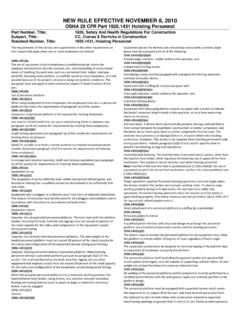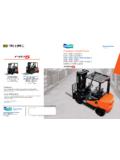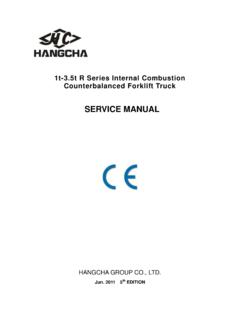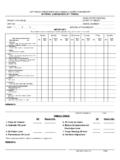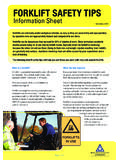Transcription of EXCERPTS THAT APPLY TO FORKLIFT WORK …
1 EXCERPTS that APPLY TO FORKLIFT work PLATFORMS EXCERPTS FROM OSHA 29 CFR (c)(1)(vi) All industrial trucks in use shall meet the applicable requirements of design, construction, stability, inspection, testing, maintenance, and operation, as defined in American National Standards Institute EXCERPTS FROM ANSI/ITSDF Introduction Part II contains requirements for the users of powered industrial trucks. Included are requirements for operator qualifications and training, operating safety rules, and maintenance practices. Elevating Personnel Only operator-up high lift trucks have been designed to lift personnel.
2 On these trucks the requirements of paragraph shall be met for the protection of personnel. If a work platform is used on trucks designed and intended for handling materials, the requirements of paras. and shall be met for the protection of personnel. Whenever a truck is used to elevate personnel, the following precautions for the protection of personnel shall be taken: (a) Comply with the design requirements in para. of this Standard. (b) Provide protection for personnel in their normal working position on the platform from moving parts of the truck that represent a hazard.
3 (c) Make sure required fall restraint means, such as guardrails and/or personal fall protection systems, are in place and properly used (see (d)(1). For personal fall protection system configurations, see Table 1. (d) Be certain that the lifting mechanism is operating smoothly throughout its entire lift height, both empty and loaded, and that all lift limiting devices and latches, if provided, are functional. (e) Provide overhead protection as indicated to be necessary by the operating conditions. (f) All components of the personal fall protection system shall be inspected and maintained in accordance with the schedule and requirements found in Section 6 of ANSI/ASSE Safety Requirements for Personal Fall Arrest Systems, Subsystems and Components.)
4 Whenever a truck is equipped with a work platform (does not include operator-up high lift trucks), precautions specified in para. shall be taken and the following additional precautions shall be taken for the protection of personnel: (a) Provide a platform that complies with the design requirements in para. (b) The platform attachment means are applied and the platform is securely attached to the lifting carriage or forks. (c) When the lifting carriage and/or forks are supporting the platform used to elevate personnel, the lifting carriage and/or forks are secured to prevent them from pivoting upward.
5 (d) The mast is vertical do not operate on a side slope. (e) The platform is horizontal and centered and not tilted forward or rearward when elevated. (f) The truck has a firm and level footing. (g) Place all travel controls in neutral and set parking brake. (h) Before elevating personnel, mark area with cones or other devices to warn of work by elevated personnel. (i) Lift and lower personnel smoothly, with caution, and only at their request. (j) Avoid overhead obstructions and electric wires. (k) Keep hands and feet clear of controls other than those in use.
6 (l) Move truck and/or platform slowly, only for minor adjustments in horizontal positioning when personnel are on the platform , and only at their request. (m) On trucks equipped with rotators, mechanically secure the rotator to prevent movement. (n) Have a trained operator in position to control the truck , or available to operate controls. When the operator is not in the operating position, engage the parking brake and block the wheels. (o) The combined weight of the platform , load, and personnel is not to exceed one-half of the capacity as indicated on the nameplate of the truck on which the platform is used.
7 (p) Personnel are to remain on the platform floor. Use of railings, planks, ladders, etc., on the platform for purpose of achieving additional reach or height is prohibited. (q) Personnel and equipment on the platform are not to exceed the available space. (r) Lower platform to floor level for personnel to enter and exit. Do not climb on any part of the truck in attempting to enter and exit. Platforms: Elevating Platforms used for elevating personnel shall have (a) a slip resistant floor surface. (b) a minimum floor space of 450 mm x 450 mm (18 in x 18 in) for each platform occupant.
8 (c) protection for personnel in their normal working position on the platform from moving parts of the truck that represent a hazard. (d) fall restraint means such as a guard rail and/or a personal fall protection system, whenever the platform can be elevated to a height greater than 1200 mm ( in). (1) A guard rail shall have a height above the platform floor of not less than 915 mm (36 in) or more than 1065 mm (42 in) around its upper periphery and include a midrail. To provide an access opening, the guard rail may be hinged or removable, or chains may be used if proper positioning is easily accomplished and a secured condition is discernible.
9 Guard rails and access opening guards shall be capable of withstanding a concentrated horizontal force of 890 N (200 lb) applied at the point of least resistance without permanent deformation. (2) Personal fall protection systems are intended to limit the distance an operator can fall from the platform and limit the forces imposed on an operator s body when the fall is arrested. Personal fall protection system configurations are based on the operator s weight. See Table 1 for personal fall protection system configurations. (a) The complete fall protection system shall consist of: (1) Components, excluding body belts and anchorages, shall meet the applicable requirements as stated in clauses 3 and 4 of ANSI/ASSE Safety Requirements for Personal Fall Arrest Systems, Subsystems and Components (2) Body belts shall have a width of at least 44mm and shall meet the applicable requirements as stated in clauses 3 and 7 in ANSI/ASSE Standard for Personal Fall Protection Used in Construction and Demolition Operations.
10 (3) Anchorage(s) shall be capable of withstanding three consecutive drops of a 113 kg (250 lb) test weight (multiplied by the maximum number of personal fall protection systems that may be attached) free falling a distance of 1825 mm (6 ft) without allowing the test weight to fall free to the ground. (b) The fall protection system shall allow personnel freedom of movement in their working area. (c) The anchorage(s) of the fall protection system shall be located on an overhead member of the platform located near the longitudinal center of the platform .
